#non-archosaurs
Text
Vancleavea campi is wonderfully weird, so it, of course, deserves a quick drawing :)

#vancleavea#drawing#art#paleoart#palaeoblr#paleontology#watercolor#palaeontology#archosauriforms#go look it up!#non-archosaurs
118 notes
·
View notes
Note
Do you like any mammals or just inverts and birds?
I appreciate mammals and everything they do, but I either don’t have much interest in being around them (most) or just flat out find them unpleasant (a fair few). in general they’re also wonderfully funny creatures. a colugo? a tamandua? pangolins? hartebeest? right whale dolphins? endless biological comedy with those freaks. I like knowing they exist.
in terms of species I truly enjoy, monotremes understand what hairy ectotherms were supposed to be like, and in my opinion everything else went off course evolutionarily. an echidna is a creature I fully support. I would like to find one someday and stare into its eyes and firsthand understand the shame of never having hatched from a shelled egg
#crevice#it’s mainly Carnivora that I can’t stand. bunch of reeking greasy hairy beasts#whoever was in charge of making non-archosaur terrestrial apex predators was truly a fool
51 notes
·
View notes
Note
i was rewatching the rite of spring segment from fantasia and i've got to wonder. Why Did We Draw Archaeopteryx Like That. i remember toys having that same, boomerang arm shaped pose too. it's like a monkey lizard more than a bird.
Ooh okay this is a fun one cause while it technically is an Archaeopteryx and is listed as such in the production draft, I don't think the design is based on Archaeopteryx at all!
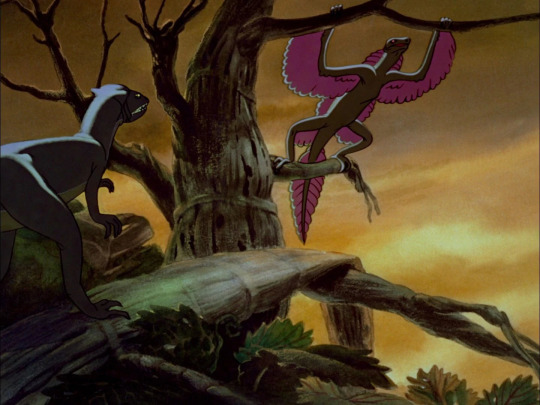
To me, this "Archaeopteryx" almost exactly resembles something else, the fascinating historical phenomenon called Proavis.
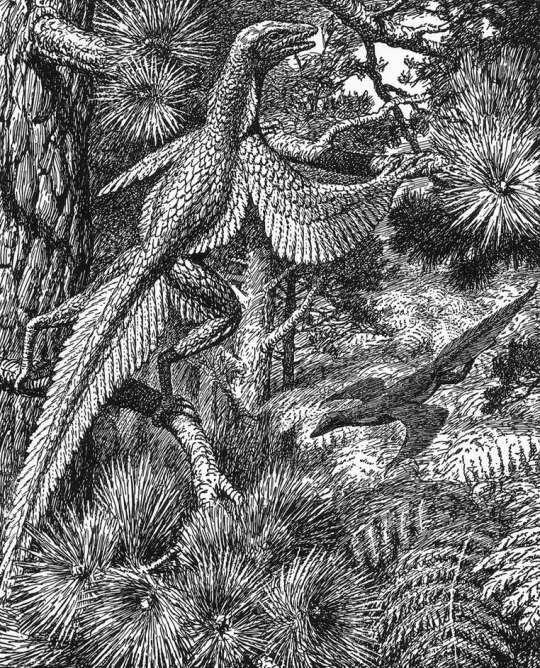
Proavis, or Tetrapteryx as some four-winged interpretations were called, was a hypothetical prehistoric creature that was proposed in the early 20th century as a best guess at what the unknown ancestor of birds could have looked like. The illustration above was drawn in 1926 by Gerhard Heilmann, a Danish artist and amateur scientist who argued that birds evolved from non-dinosaurian archosaurs like Euparkeria. In his 1916 book Vor Nuvaerende Viden om Fuglenes Afstamning and the 1926 English translation The Origin of Birds, he presented Proavis as the imagined midpoint between a scaly ground-running archosaur and Archaeopteryx, which at the time held the title of The First Bird.

Other versions of the same hypothesis, like William Beebe's Tetrapteryx above, were published and discussed around the same time, but it was Heilmann's Proavis that gained immense popularity to the point that bird evolution was considered essentially "solved" for decades. It was also painted by Zdeněk Burian, one of the Old Greats of palaeoart, which kept the concept alive in dinosaur books for decades as well.

Of course further study has shown this hypothesis to be incorrect and that birds are instead members of Dinosauria (and honestly Heilmann either missed or ignored a lot of evidence for a dinosaurian origin of birds even in the 1910s), but the Proavis to me remains a beautiful and fascinating concept that represents scientists and artists striving to understand the prehistoric world and the passage of evolution, much like we still do today!
And of course, its popularity in the early 20th century put it at the perfect time for Fantasia's artists to take... let's say heavy inspiration from Heilmann's imaginary Proavis when depicting a creature that was intended to be Archaeopteryx the whole time! The pattern of feathers matches up almost exactly, although the larger leg wings might have been inspired by Beebe's Tetrapteryx as well:
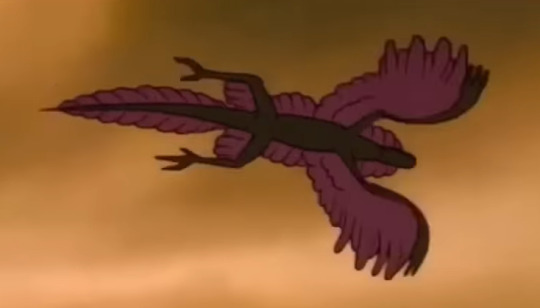
So to get back to your original question that led to this whole deep dive, artists didn't actually Draw Archaeopteryx Like That except when they were mistakenly drawing something that wasn't Archaeopteryx at all! If you want to read more about the Proavis and Tetrapteryx I recommend this Tetrapod Zoology blog post by Darren Naish, he does into more depth about the history of the concept and some of the unusual evolutionary ideas that Heilmann used to arrive at this weird and cool imaginary creature!
798 notes
·
View notes
Text
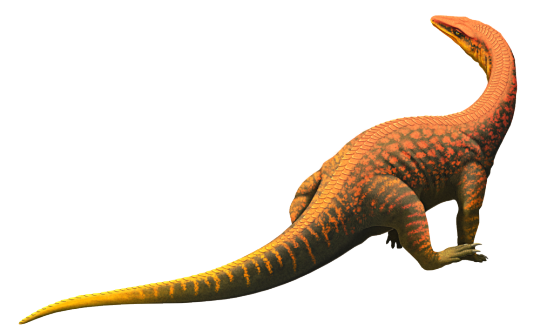
Mambachiton fiandohana lived during the mid-Triassic, about 237 million years ago, in what is now Madagascar – which at the time wasn't yet an island, still being connected to both east Africa and India as part of southern Pangaea.
It represents the earliest known branch of the avemetatarsalians, or "bird-line archosaurs", a major group of the archosaur reptiles that also includes pterosaurs and dinosaurs/birds.
It's only known from a few fragments but it was probably around 2m long (~6'6"), and would have been a carnivorous lizard-like animal with a long neck and semi-erect quadrupedal limb posture.
Unexpectedly for a bird-line archosaur it also had a staggered double row of bony osteoderms along its back, suggesting that the very earliest avemetatarsalians had some crocodilian-like armor. This seem to have very quickly been lost, though – there's no sign of osteoderms in the next branches to split off after Mambachiton, the aphanosaurs and pterosauromorphs – and although they occur again later in one dinosauriform and various non-avian dinosaurs, this appears to be multiple cases of independent re-evolution rather than retaining the original ancestral trait.
—
NixIllustration.com | Tumblr | Patreon
#science illustration#paleontology#paleoart#palaeoblr#mambachiton#avemetatarsalia#archosaur#reptile#art#there's some sparse fuzz if you look closely
310 notes
·
View notes
Text
reptiles are the only TRUE genders
all of these clades can be found on the wikipedias
#trans#nonbinary#reptiles#birds#dinosaurs#prehistoric life#genderqueer#this post was made by a nonbinary intersex individual plz just go along with the joke#poll
421 notes
·
View notes
Text
listening and learning. the future has always been female
by Michael Roppolo
June 8, 2023 / 1:32 PM / CBS News
Researchers have identified the first known case of a crocodile making herself pregnant — and producing a fetus that was genetically identical to herself. The findings were published Wednesday by a team led by evolutionary biologist Warren Booth from Virginia Tech in Biology Letters, a journal published by the Royal Society.
In 2018, officials with the Parque Reptilandia in Costa Rica found 14 eggs in a female's enclosure. The crocodile had been in isolation since the age of 2, yet she still managed to lay a clutch of eggs at 18.
"Given the period of isolation from mates, these would normally be considered non-viable and discarded," the researchers wrote. But the officials gathered seven eggs that appeared viable and kept them in an incubator.
There were several signs that one of the eggs may be viable, Booth told CBS News.
"Viable eggs are often bright white, whereas infertile may be more yellowish," he said. "When held up to a flashlight, viable crocodile eggs will have a distinct band, whereas non-viable will simply glow yellow."
Costa Rica officials reached out to experts in the U.S. for consultation — ones that specialized in parthenogenesis. The term is derived from the Greek words "parthenos," meaning "virgin," and "genesis," meaning "origin," according to Encyclopedia Britannica.
Booth, and co-author Gordon Schuett of Georgia State University, had published multiple papers on the topic. As such, they were the "go-to people," Booth told CBS News.
Once considered rare, so-called virgin births have been documented among various species — including sawfish, snakes, sharks, and birds. The process, which is more common in the plant and insect worlds, allows a female organism to replicate itself without fertilization from a male.
In 2021, a study found that California condors can have virgin births. Researchers with the San Diego Zoo Wildlife Alliance said genetic testing confirmed that two male chicks that hatched in 2001 and 2009 from unfertilized eggs were related to their mothers. Neither was related to a male. In 2019, an anaconda housed with two other females gave birth. DNA testing would later confirm that the anaconda babies were reproduced through parthenogenesis.
In the case of the crocodile in Costa Rica, three months after workers found the eggs, none had hatched and only one egg was found to have a fully formed but nonviable fetus. DNA analysis would later determine that the fetus was 99.9% genetically identical to its mother.
Virgin births could be happening in crocodiles without anyone realizing, according to the researchers.
"These findings, therefore, suggest that eggs should be assessed for potential viability when males are absent," they wrote.
The authors suggest that in these cases among reptiles, birds, and now crocodiles, there may be a common evolutionary origin.
"This discovery offers tantalizing insights into the possible reproductive capabilities of the extinct archosaurian relatives of crocodilians and birds, notably members of Pterosauria and Dinosauria," they write, referring to flying reptiles that have been described as "close cousins" of dinosaurs.
Booth told CBS News that crocodiles are at the base of a lineage known as the archosaurs, with the most recent members being birds. All of these creatures use the same complex form of parthenogenesis, or terminal fusion automixis. It is unlikely they all developed independently.
"The cool aspect is that in between crocodiles and birds are the pterosaurs and dinosaurs," he added. "Given that all of these lineages use the same mechanism, it is highly likely that pterosaurs and dinosaurs also had the capacity to produce parthenogenetically."
#crocodilians are so so so so cool anyway one of my forever faves but this is a whole other level of cool#i looooove that there are species that can do this
381 notes
·
View notes
Text
Okay! Quick paleontology lesson!
First, the difference between Avian and Non-Avian dinosaurs! Avian dinosaurs are birds, while Non-Avian dinosaurs are what we traditionally think of as dinosaurs!
The ancestors to the Non-Avian dinosaurs, the Archosaurs, appeared anywhere from 252.2 million years ago to 201.3 million years ago, basically most of the Triassic Epoch!
The Non-Avian dinosaurs went extinct around 66 million years ago, and the T-Rex (the specific dinosaur Pomme has) went extinct around 65 million years ago!
Bad is at the very least 66 million years old and may be as old as 252.2 million years old!! There is a chance that Bad lived through the entirety of the Mesozoic Era (252.2-66 million years ago), which encompasses all of the dinosaurs!
49 notes
·
View notes
Note
I hope Bilbo's feeling better, poor buddy!
If you were to create a scientific name for dragons/drakes, what would it be? In my fantasy writing they're a clade of non-archosaur diapsids and I'd love a professional recommendation lol.
Thank you, Bilbo's feeling much, much better and finally has his appetite back today!
That's a fun question! Here are my personal picks...
Draconis could be the genus for your standard Western-fantasy-style dragons. Maybe Draconis draconis as the type species for your typical Medieval guys, Draconis ignis for fire-breathers, etc. I thought about Draco but that's already an occupied genus, taken by flying lizards (the real ones).
For not-quite-dragons like wyrms, wyverns, and amphitheres, Pseudodraconis would be a genus name that makes a lot of sense and has strong real-world precedent.
Knowing how eurocentric naming conventions have been in the past, Asian dragons would probably get lumped into something like Draconis orientalis. I'd totally put them in a separate genus, though. Maybe Sindraconis?
176 notes
·
View notes
Text
I think it's fun to think about how (5e:ish) dragons might have evolved and I've been thinking about it again lately. Obviously things probably work uh, different in a world with so many active gods, but I still think it's fun to think about. Besides, some of those "a god did it" stories may just be in-world explanations for something you don't understand, or the god set the stone in motion but it was still a slow/gradual process.
This is my current hypothesis, at least for how it might have happened in Sorrel's world:
Dragons would belong to the Archosaurs ("ruling reptiles") clade. This group includes crocodilians, birds and non-avian dinosaurs, pterosaurs and some others. I think this fits them well as they show characteristics from all these types of animals. We also have a bonus nod to some birds being very intelligent animals, as true dragons are (at least) human level intelligence also.
I think their direct ancestor was likely similar to the Drakes, which in 5e are described as smaller and lesser relatives of dragons, about as intelligent as horses, with elemental affinity and able to understand draconic (which imo goes against "horse level intelligence" since understanding a language requires Intelligence but okay).
Reading about various dragon-like creatures and their abilities I think the dragon ancestors developed reasonably high intelligence and a basic language first, then learned to use magic before evolving into true dragons. My theory is that when they learned to tap into the Weave they basically used it to modify their own genes, allowing them an extra set of limbs, elemental affinity/abilities, growing to massive size etc. Basically unlocking a bunch of cheat codes that in turn enabled them to evolve into an apex predator. The wings probably came first and allowed them a massive survival boost as well as altering how they hunt etc, with breath weapons following as part of their hunting strategy etc.
Side effects of their evolutionary path include dragons being solitary, long-lived, slow-growing and territorial - they require a lot of resources and by necessity cannot live too close to each other. For most of their existence this wasn’t really an issue but it is now with humanoids being so present. Dragons are slow to age and procreate and there's not many of them, if hunters kill off several of them it's a noticeable blow to their population.
Psuedodragons are a very early offshoot on the dragon evolutionary tree, they have rudimentary language and wings but lack magic otherwise. Not true dragons, but closely related to them.
Faerie dragons are another early offshoot, they have language and magic, are described as closely related to psuedodragons but are arguably closer to true dragons than they are. Only as large as a cat - likely ended up on a different evolutionary path than true dragons, focusing on a much smaller size as to not compete with their much larger relatives.
Wings are a bit tricky in general, especially in animals like Drakes where some have them and some don’t. Since it’s a BIG deal to suddenly have an extra pair of limbs, I think it’s likely to be the result of magic influence, not “normal” evolution. But then we have creatures like the psuedodragon, which has wings but no particular magic ability. Maybe they got that far but then as the true dragons became increasingly magical, psuedodragons hopped off that train and focused on a different niche, never developing and perhaps even dropping what rudimentary magic ability they once had?
#sorrel#dragons#dragon evolution#dnd#5e#I am having FUN thinking about thissss#and I always love thinking about high intelligence in non-human species#bc it makes you think about what a different species might prioritise and so on
13 notes
·
View notes
Note
is there a known point at which humans and pokemon diverged?
yes! i've been meaning to talk about something similar to this, so we'll be needing to expand the scope of this ask by, like, a lot. so, first we do kind of need to answer what a pokemon actually is, what it means when we say an organism is a pokemon. and to do that: i'm going to tell you about dinosaurs and trees. stick with me, here, i'm having fun. here's a little phylogeny lesson.
we'll be using dinosaurs as our example to talk about evolutionary relationships: dinosauria is a clade, also called a monophyletic group. that means that it is defined as one common ancestor and all its descendants. genera, families, and so on are usually clades (there are some exceptions, usually resulting from outdated definitions already being important and widely accepted before new data mixes up how we thought the family tree looked. for example, fish isn't a monophyletic group, because they exclude the tetrapods. if fish were a clade, we'd all be fish. as we should be).
here's a very, very simplified family tree of the archosaurs, the group that includes crocodiles, dinosaurs, and pterosaurs. think of this whole thing as a tree branch that splits and diverges as new species and groups arise.
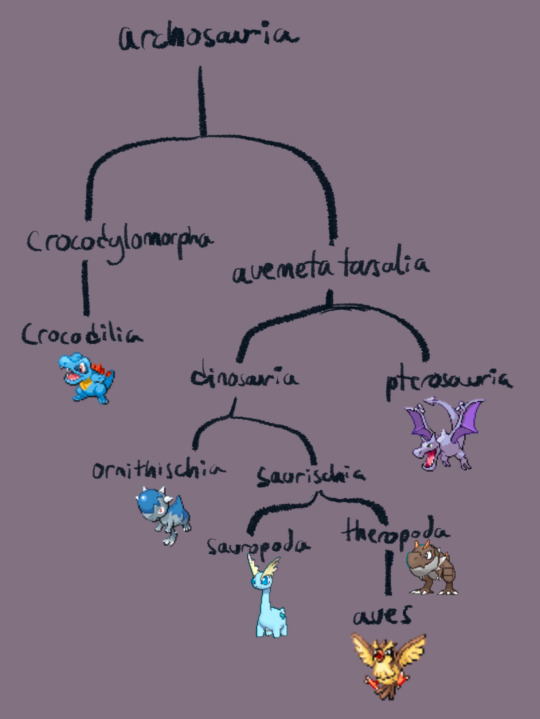
a monophyletic group, or clade, is like if you snip a branch from the tree and include the entire branch. so, if you snip this tree at the dinosauria branch, it'll have the ornithischia and saurischia (including sauropoda, theropoda, and aves) twigs on it, so all ornithischians and saurischians are dinosaurs. (in case you didn't know, birds are dinosaurs, and that's why!) basically, if it evolved from a dinosaur, it will also be a dinosaur.
(the next two terms are not actually relevant to our discussion, but if i'm defining monophyly, i need to tell you about the other two -phyly's, so bear with me. now, a lot of times when people say "dinosaurs", they don't mean to include birds- this is called a paraphyletic group. this means it excludes a part of the branch- so, if you snipped the tree at dinosauria, and then discarded the aves twig, you would have a paraphyletic group including ornithischia, sauropoda, and theropoda minus the aves.
the third common type of grouping is polyphyletic, which is when multiple branches of a tree are grouped together. so, if you snipped the tree at, say, crocodilia, pterosauria, and sauropoda and made those separate branches a group without anything else, that would be a polyphyletic grouping.)
.
now, let's look at trees. the word 'tree' doesn't describe an evolutionary grouping like the previous words do, 'tree' is just a descriptor that refers to how something looks, or what physical features it has- trees have woody stems, are perennial, and have branches with leaves, for example. there are species from all around the plant kingdom that are trees, that are entirely unrelated from one another! for example, an oak tree is much more closely related to a rose bush than it is to a pine tree. so "tree" is a morphological descriptor, not an evolutionary one.
now, what are pokemon? let's look at some of the traits every single pokemon shares. all pokemon have one or two out of the 18 types. they can all learn moves and have abilities, and can be caught in pokeballs. there is no one monophyletic group that includes all pokemon and excludes all non-pokemon. hell, there are things outside of the kingdom of life that are pokemon, look at trubbish. that's just a bag of trash that came to life. that's not related to literally anything. god i love trubbish
that is to say, pokemon is a morphological descriptor, just like trees, and not like dinosaurs. it is a group of things with particular characteristics with no regard to how they're related evolutionarily.
so, now we loop back to your original question: when did humans diverge from pokemon? in fact, humans evolved from organisms that were pokemon. almost every vertebrate is a pokemon, with the majority of the exceptions being tiny, so humans not being pokemon is pretty weird given we are Big Vertebrates, we're as far as we know the Only Big Vertebrate that isn't a pokemon.
our lineage lost its.. pokemon-ness right around half a million years ago. apologies if i get some specifics wrong here, human evolution isn't my forte- but the first non-pokemon human was Homo heidelbergensis. H. heidelbergensis gave rise to Homo neanderthalensis (commonly known as neanderthals) and Homo sapiens- that's us! every other member of the genus Homo, and the great apes more broadly, are pokemon. of the non-pokemon Homo lineage, Homo sapiens (us) is the only remaining species (though many people do have a fair bit of neanderthal heritage in there).
well, why did our little human lineage stop being pokemon? it's generally a pretty big advantage to be able to breathe fire, or shoot ice lasers, or use telekinesis or whatever, so there's a strong selective pressure against losing pokemon-ness, despite its high energy cost. well, as far as i know, the best theory we have for that has to do with our relationship with pokemon, and the fact that we're so good at becoming friends with them. seriously! ancient humans befriended and worked with the pokemon around them, so much so that they essentially lost the need to be pokemon themselves.
because most pokemon require much more energy than the average non-pokemon to function, due to the aforementioned fire breathing and ice lasers and such, if there's no strong selective pressure for a species to keep being a pokemon, that trait will generally be selected against. summed up: the reason you and i aren't pokemon is because we're friends with pokemon. :)
oh, and- our closest non-pokemon relatives are basically everything else in the genus Homo. that's the ralts line, sawk, throh, and yes, of course: mr. mime. so next time you're out training, be sure to say hi to your closest pokemon cousins.
whew! that was a longwinded answer for something that technically could've been, like, a paragraph, but thank you for reading my tangents if you did.
330 notes
·
View notes
Text
paleo exam tomorrow on amphibians, amniote origins, and non-archosaur reptiles! as is customary, go ahead and ask paleo questions! would like to focus on the above topics, but anything is fair game
4 notes
·
View notes
Text
Sarcosuchus will be the dominant predator in the swamps. Like its extant relatives, sarcosuchus hunts by ambushing animals that come to get a drink, grabbing them and either drowning them or thrashing them to death.
Sarcosuchus cannot be tamed, but can be "befriended" similar to foxes by raising a hatchling. Beware that mother sarcosuchus fiercely guard their nests.
In real life, sarcosuchus was an "uncle" to modern crocodiles that lived in niger around 120 million years ago, it was one of the largest non-dinosaurian archosaurs of the Mesozoic era, surpassed only by the likes of Deinosuchus.
8 notes
·
View notes
Text
March Madness Day 2!
Mosasaurus
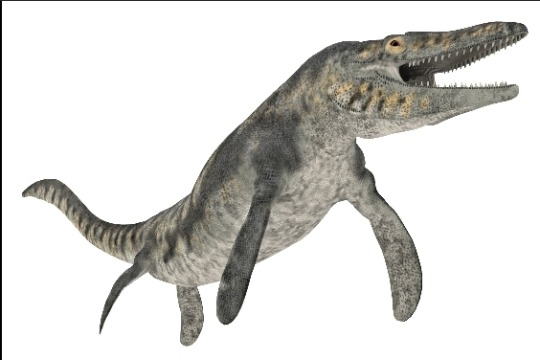
Or Elasmosaurus

So, why aren't yhese guys considered dinosaurs? Here's a few reasons:
1.) Both are marine organisms. Dinosaurs (at least non-avian) are terrestrial.
2.) Mosasaurus is a aquamate. Basically, a giant sea lizard.

Dinosaurs are archosaurs.

Elasmosaurus is a sauropterygian like Nothosaurus.

Which one do you want to keep in the competition? REBLOG for MOSASAURUS.
LIKE for ELASMOSAURUS.
Voting open until tier 2 begins (March 16).
5 notes
·
View notes
Text
It Came From The Wastebasket #15: Rauisuchian Revolution
Pseudosuchians, or "croc-line archosaurs", are one of the two major lineages of archosaur reptiles, alongside the avemetatarsalians (pterosaurs and dinosaurs). Although today they're represented only by crocodilians, they were especially successful and diverse back in the Triassic – and it was only after a mass extinction took out most of them that the dinosaurs were able to rise to prominence for the rest of the Mesozoic Era.
A grouping of pseudosuchians traditionally known as "rauisuchians" had upright limbs in a distinctive "pillar-erect" hip arrangement. Many of these croc-relatives were large quadrupedal predators, but others developed bipedal theropod-like postures, with some so remarkably convergent that they were initially misidentified as ornithomimosaurs.
The first rauisuchians were discovered in the 1930s, represented only by fragmentary remains, and while they were initially recognized as being pseudosuchians their exact evolutionary relationships within that group were poorly understood for a long time. Over the next several decades they were classified with aetosaurs (early armored pseudosuchians), then ornithosuchids (even earlier pseudosuchians), and then erythrosuchids (not even pseudosuchians but an earlier type of archosauriform).
More complete fossil discoveries and better cladistic analysis methods in the 1980s led to them being classified as being very closely related to crocodylomorphs, with three main lineages recognized: the prestosuchids, the rauisuchids, and the poposauroids.
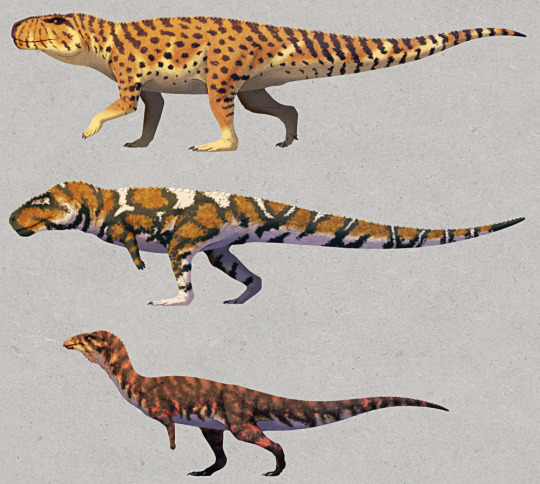
The "prestosuchid" Prestosuchus chiniquensis, the rauisuchid Postosuchus kirkpatricki, & the poposauroid Effigia okeeffeae (not to scale)
But even by the end of the 20th century "Rauisuchia" had never actually gotten a formal definition, and it had very much become a wastebasket taxon for a variety of paracrocodylomorph pseudosuchians that didn't easily fit into any other major lineages.
In the 2000s renewed interest in rauisuchians' anatomy and evolutionary relationships led to increasing recognition that they weren't even a single defined group, with various species instead falling into different points along an "evolutionary grade". The poposauroids and rauisuchids still seem to be distinct lineages, but the "prestosuchids" were found to be polyphyletic, with some forming a grade between the other two "rauisuchid" groups and others turning out to not even be paracrocodylomorphs.
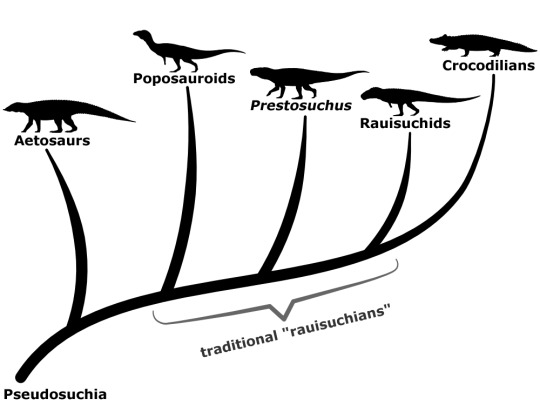
And although the taxonomic concept of "Rauisuchia" as a distinct group has now been abandoned, the term "rauisuchians" does still remain in common use as an informal name for these animals – probably because it's much more concise than saying "non-crocodylomorph paracrocodylomorphs".
———
Nix Illustration | Tumblr | Twitter | Patreon
#it came from the wastebasket#wastebasket taxon#taxonomy#rauisuchia#prestosuchus#prestosuchidae#postosuchus#rauisuchidae#effigia#poposauroidea#pseudosuchia#croc-line archosaurs#paleontology#art#science illustration#paleoart#palaeoblr
306 notes
·
View notes
Note
Another thing is that old-timey dinosaurs didn't move like real animals. They moved like monsters. When I look at those weird lumpy rexes, I can't imagine how they'd move, beyond "guy in a T. rex costume", like a weird awkward waddle. Looking at the more accurate ones, it's easy to understand how they move and what they'd look like in motion.
I've never heard of Dollo; who was he and what was his bad theory?
Yeah that's fair, it's annoying to see the man moving
that said, the raptors in the original JP were also men in a suit - but they compensated to make it look closer to natural
Dollo was a scientist in the 1800s who created a theory that organisms can't re-evolve structures they lost. he didn't know genetics, so he didn't know that features can be turned on and off and thus it can be possible to re-evolve lost structures.
but, because of that theory, he and others decided birds couldn't be dinosaurs. this was because, at the time, we had no evidence of a dinosaur furcula (wishbone) - or, at least, we thought we had no evidence of one. We did, however, have "thecodonts" (early archosaurs) with wishbones - meaning that, if birds evolved from dinosaurs, they would have had to re-evolve the wishbone
turns out a) non-avialan dinosaurs did have wishbones, they just don't fossilize well b) we did have some, we just misidentified them and c) yeah you can redevelop things actually
so we went from birds being dinosaurs being the best supported hypothesis to almost no one believing it within a few years at the end of the 1800s
leading to the "dinosaur dark ages" (dinosaurs are slow evolutionary failures) that was the first 60 years of the 20th century
so, yeah. we can blame dollo, 100%, for everyone being ignorant about dinosaurs.
114 notes
·
View notes
Note
You say you dug up those noncanon concepts for the 2017 beta draft from your files? What other ideas do you have from there, are they also Hamster's Paradise early rejected ideas?
Mostly just a jumble of old rough doodles on an older drawing app whose name I can't even remember, eh I've found Sketch much better anyway.
Most are earlier doodles of the beta Hamster's Paradise post, nothing really new there, though there were also some random art of all sorts of a spec evo grab bag of other ideas I had back then just playing around with speculative evolution tropes, years ago.
Some notable non-Hamster's Paradise ones:

Pentapodal indricothere-like kangaroo descendant that turned its tail into basically a fifth leg. Also some carnivorous macropods that may have influenced the loupgaroos and the harmsters.
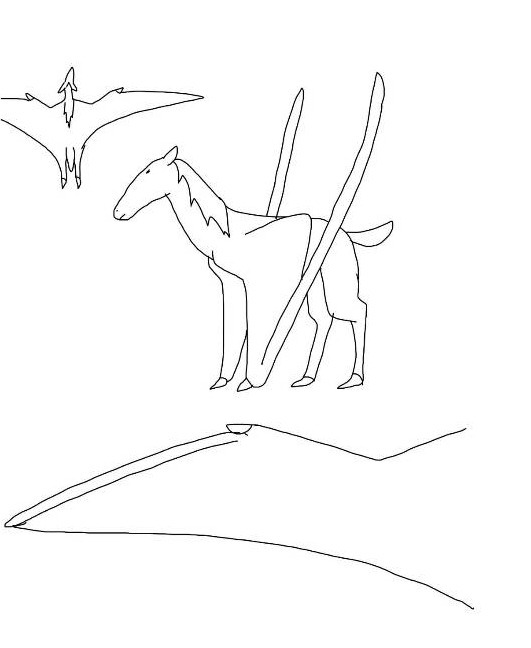
An attempt to wyvern-ize a pegasus after hearing some spec evo explanation on why the dragons of Westeros are all wyverns for "realism".

Some big headed baleen whale azhdarchids. How and where and why these could evolve, I have no clue.

A semi "realistic" take on Meowth from Pokemon interpreting it as less of a cat and more of a feline-esque primate with the coin as a brightly-colored display organ. Also probably would involve the heightened intelligence and apparently latent ability to learn human language only some individuals learn.

...whatever the hell this is. I don't even know anymore, it was a long time ago.
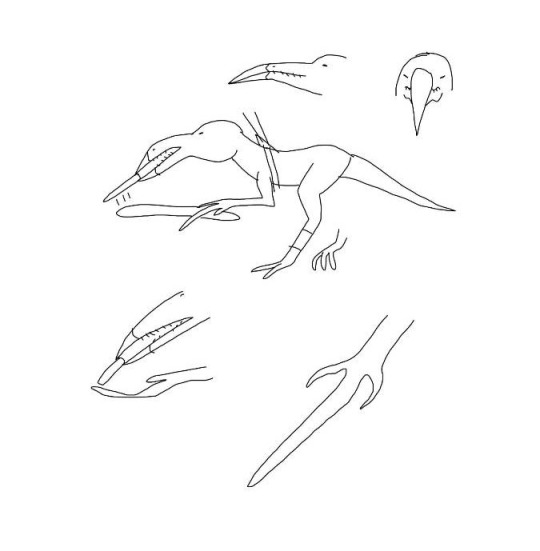
Sapient "dinosauroid" descended from probably some generic maniraptoran, with the half-beak and teeth used as a third manipulatory organ. Also long middle fingers for some reason, maybe a scansoriopterygid?
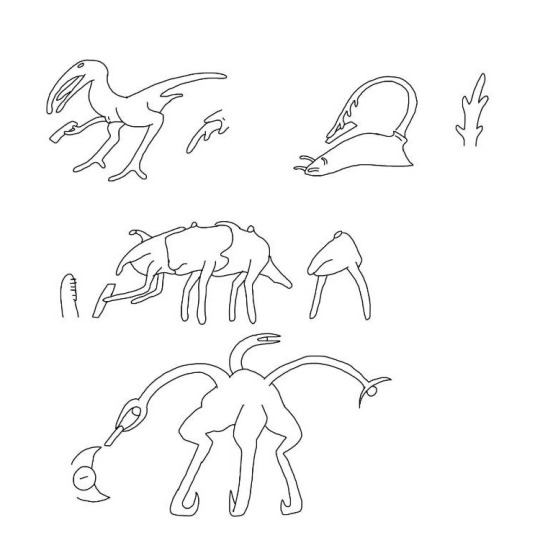
And on the topic of sophonts and manipulatory organs, some attempts at sapient aliens as un-humanoid looking as possible, including some modular bipeds and some kind of triradially symmetric one that uses the eyelids of its three eyestalks as manipulators.

An entirely scrapped project labeled "Lystronia" with the premise of an alternate timeline where the Permian Great Dying was worse and killed the archosaurs and cynodonts too, and with no crocodilians, dinosaurs, pterosaurs or mammals to eventually outcompete them the dicynodont Lystrosaurus took over like it did irl, but then stayed in prominence and dominated the Mesozoic and Cenozoic.
And yep that's basically all, as well as the pop-culture reference one-offs, the planet of the pseudosnakes one, and a Tullimonstrum seed world that went nowhere as we simply didn't know much about what phylum it even is. Hamster's Paradise was the only one that really took off, conceptually.
26 notes
·
View notes